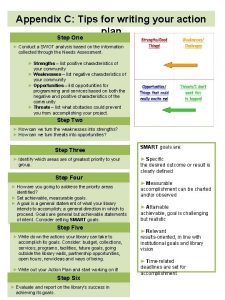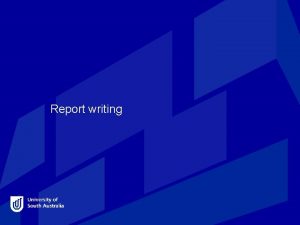Appendix C Tips for writing your action plan

- Slides: 1

Appendix C: Tips for writing your action plan Step One ► Conduct a SWOT analysis based on the information collected through the Needs Assessment. ► Strengths – list positive characteristics of your community ► Weaknesses – list negative characteristics of your community ► Opportunities – list opportunities for programming and services based on both the negative and positive characteristics of the community ► Threats – list what obstacles could prevent you from accomplishing your project. Step Two ► How can we turn the weaknesses into strengths? ► How can we turn threats into opportunities? Step Three ► Identify which areas are of greatest priority to your group. Step Four ► How are you going to address the priority areas identified? ► Set achievable, measurable goals. ► A goal is a general statement of what your library intends to accomplish; a general direction in which to proceed. Goals are general but achievable statements of intent. Consider setting SMART goals. Step Five ► Write down the actions your library can take to accomplish its goals. Consider: budget, collections, services, programs, facilities, future goals, going outside the library walls, partnership opportunities, open hours, new ideas and ways of being. ► Write out your Action Plan and start working on it! Step Six ► Evaluate and report on the library’s success in achieving its goals. SMART goals are: ► Specific the desired outcome or result is clearly defined ► Measurable accomplishment can be charted and/or observed ► Attainable achievable, goal is challenging but realistic ► Relevant results-oriented, in line with institutional goals and library vision ► Time-related deadlines are set for accomplishment

